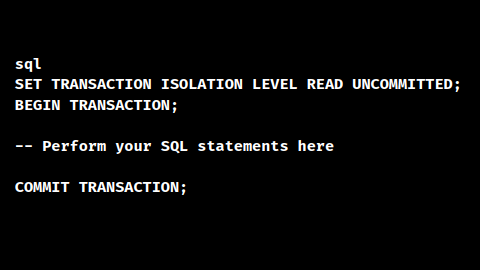In SQL Server, BEGIN TRANSACTION & READ UNCOMMITTED are two events in the transaction. With our SQL Server Support, Bobcares can assist you with your questions.
SQL Server: BEGIN TRANSACTION & READ UNCOMMITTED
With the BEGIN TRANSACTION, a new transaction in SQL Server starts. It is a series of one or more SQL statements that run as a single piece of work. A database’s ability to preserve data consistency and integrity depends on transactions.
One of the isolation levels that we use in SQL Server is READ UNCOMMITTED. Regarding read-and-write operations on the data, the isolation level controls how transactions interact with one another.
When a transaction’s isolation level is set to READ UNCOMMITTED, it has access to other concurrent transactions’ uncommitted changes. The “dirty read” is the lowest level of isolation available. Because it has the ability to read data that hasn’t been committed yet and might later be rolled back.
More On READ UNCOMMITTED
The following are the main ideas to consider regarding the READ UNCOMMITTED:
1. Dirty Reads: When other concurrent transactions change data, the READ UNCOMMITTED flag can read those data. This may result in “dirty reads” where a transaction accesses intermediate or unsaved data. This may in turn create rollbacks, thereby causing problems.
2. No Locking: Locks are not used by READ UNCOMMITTED to stop other transactions from changing the data that is being read. As a result, there is a greater chance of running into concurrency problems, such as reading incorrect data.
3. Data Inconsistency: If many transactions are making multiple changes to the same piece of data, READ UNCOMMITTED may result in unstable data because it doesn’t lock and permits dirty reads.
4. Use Cases: In situations when maximum read efficiency is a top goal and uniform data is not a crucial need, we can use the READ UNCOMMITTED. For instance, using READ UNCOMMITTED helps lessen locking and contention on often visited tables in some reporting contexts when real-time stability is not a priority.
How to set READ UNCOMMITTED?
In situations when increasing read efficiency is a top goal and data consistency is not a crucial need, the READ UNCOMMITTED is generally used. For instance, using READ UNCOMMITTED helps lessen locking and contention on often visited tables in some reporting contexts when real-time stability is not a priority.

However, using the READ UNCOMMITTED needs to be done with caution because it can have unintended consequences and affect data integrity. In order to protect uniform data and prevent any data errors, it is generally good to use greater isolation levels, like READ COMMITTED or REPEATABLE READ.
[Need to know more? Reach out to us by clicking here.]
Conclusion
To sum up, the article contains the details on BEGIN TRANSACTION & READ UNCOMMITTED in SQL Server.
PREVENT YOUR SERVER FROM CRASHING!
Never again lose customers to poor server speed! Let us help you.
Our server experts will monitor & maintain your server 24/7 so that it remains lightning fast and secure.







0 Comments